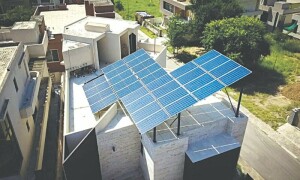I HAVE written earlier about the Pakistan Quarters when a proposal for its development was made in 2018 under very different political circumstances. At that time, the Sindh government had some control over land in the city. However, today, developers have completely taken over land-use decisions due to the policies of the previous government.
The Pakistan Quarters consist of Martin East, Martin West, and Jahangir Quarters. To avoid the misuse of land as in the case of Bahria Town and to avoid creating homelessness and misery as in the case of the KCR-related evictions and the Gujjar nullah, Orangi nullah and Mahmoodabad nullah demolitions, a rehabilitation process should be guaranteed, that will not result in homelessness and hunger or force people to live under the sky without water, electricity, schools, and employment on the rubble of their homes for years.
The Pakistan Quarters on which the government wishes to construct apartments consist of about 335 acres and have a population of around 90,000, or 13,000 households. There are five types of residents in the Quarters: i) there are the original allottees. Most of them are probably dead; ii) there are the children and grandchildren of the allottees; iii) there are those who have rented out their homes to others; iv) there are those who have not paid their dues to the state; v) there are those who have sold their houses and have left.
All these categories need to be identified, and their numbers worked out so that a just and equitable system of rehousing, relocating, or removal can be worked out. This work could be handled by a Karachi-based academic institution of architecture and planning, as it will lead to a better understanding of design and planning-related problems of rehabilitation for low-income and lower-middle-income settlements for students and their teachers.
Fair rehabilitation is needed for Pakistan Quarters residents.
All these categories and their needs and numbers should be identified, and their financial status and housing needs worked out so that a just, equitable, and transparent system of re-allotments or removal can be worked out. This, as a survey, is not difficult to do.
So far in Karachi, the ‘rehabilitation’ processes have been very poor and court judgements have supported the demolition of homes and settlements, saying that rehabilitation should be provided one year after the demolition. The problem of where the residents would live after the demolition of their homes has been ignored. Even then, after more than four years the rehabilitation of demolished homes, there has been no programme for rehabilitation, and the courts have failed to force the government to comply with their judgements.
If a programme of such a large nature as the proposed Pakistan Quarters is undertaken, it can be an asset to the city if it is aesthetically planned and executed. For this, it is necessary that there should be no nepotism in the appointment of the architect. I would even suggest that a national or international competition for the design be held and judged by an international jury.
Martin Quarters also contains the first residential accommodation that was built for the lower-income government employees in Karachi after partition; therefore, it also has historic importance. Apart from very important cultural importance for the city as a whole, it has also been a part of many political movements, often reactionary.
Knowing the nature of government administrative systems, the management and construction work for the redevelopment of the quarters will probably be given to a developer. This is the trend today. It might even be given to a foreign developer. In both cases, our experience has been terrible. So it is suggested that a committee consisting of well-known and public-spirited citizens be created to oversee the project. Such a committee would also contain a representative of the developer and technical persons appointed by the committee.
It should be understood that over the past 74 years, the residents of Pakistan Quarters have created various communities and strong identities. In the process, they have created sports clubs, religious associations (mosques and imambargahs), libraries, and protected land; for these activities. These should be identified, and spaces for them allocated next to the communities who operate and use them. Funds for their survival should also be allocated.
It is hoped that for once we will be able to build something that is of benefit to the poor and lower middle-income groups of Karachi and not create a development that is ugly, unaesthetic, and exploitative and which provides the market the opportunity to extract maximum value out of land at the cost of the city’s built and social environment.
The writer is an architect.
Published in Dawn, October 9th, 2023












































